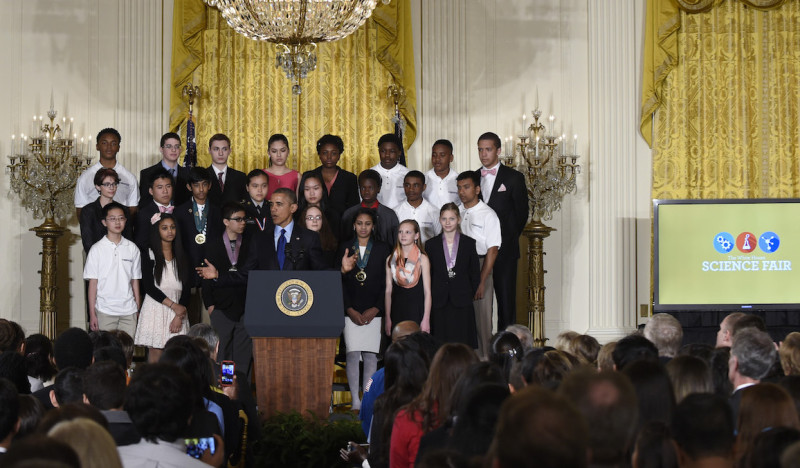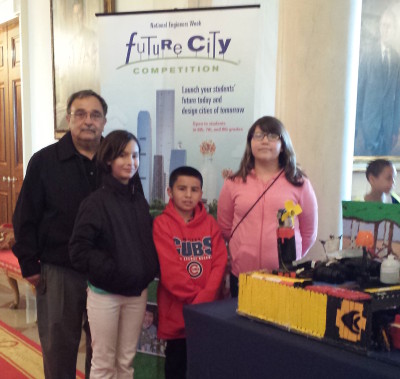 This week more than 100 budding young scientists and engineers presented their inventions to President Obama at the fifth annual White House Science Fair. Elementary, middle and high school students showcased innovations ranging from robotics, alternative fuel sources and cybersecurity to software that identifies breast cancer and 3D-printed wheelchair accessories. There was even a hiccup-curing lollipop.
This week more than 100 budding young scientists and engineers presented their inventions to President Obama at the fifth annual White House Science Fair. Elementary, middle and high school students showcased innovations ranging from robotics, alternative fuel sources and cybersecurity to software that identifies breast cancer and 3D-printed wheelchair accessories. There was even a hiccup-curing lollipop.
The 2015 Science Fair highlighted the importance of encouraging more women and minorities in science, technology, engineering and math (STEM), and a sixth grade team from New Mexico represented the important contributions they can make in the STEM fields.
Led by New Mexico teacher and NEA member Jimmy Lara, Casandra Dauz, Jose Valdez and Jaleena Rolon of James Rodriguez Elementary in Espanola, New Mexico, created a “City of Crystal Water,” a city of the future where they were challenged to choose two foods (one vegetable and one protein) and design a way to grow enough of each within the future city borders to feed all of the citizens for at least one growing season. They chose fish (because they are healthy sources of protein and can be raised and processed in fish pens) and carrots (because they, too, are healthy and can be easily grown without soil using hydroponics.) They also had to address the problem of energy distribution to their city, and they used hydro energy and wind turbines.
Recognizing the importance of connecting their idea with their rural, desert community’s cultural diversity, the team incorporated four languages into their City presentation: Spanish, English, American Sign Language, and Tewa, a Tanoan language spoken by Pueblo Native Americans. Jose is from the Santa Clara Pueblo, Cassandra’s church accommodates the hearing impaired, and Jaleena is the daughter of recent immigrants. The team earned recognition for Most Unique Architectural Model at the New Mexico Regional Future City Competition.
 Jimmy Lara, Jaleena Rolon, Jose Valdez and Casandra Dauz of James Rodriguez Elementary at the White House on March 23.
Jimmy Lara, Jaleena Rolon, Jose Valdez and Casandra Dauz of James Rodriguez Elementary at the White House on March 23.
Lara has always worked to integrate STEM into his curriculum and founded the school technology committee so others could do so at James Rodriguez Elementary. He gathered a team, wrote a technology plan, got resources and guidance from Chinese Institute of Engineers New Mexico Chapter and the Los Alamos National Security, and now much of the school curriculum is driven by technology.
Lara has been an elementary educator for 26 years and was thrilled to host his team of students to the nation’s capital. “For two Hispanic girls and a member of the Pueblo to be invited to the White House Science Fair was a huge honor for our school and community,” he says.
The students were thrilled at the prospect of visiting the White House and meeting the president, but also by flying on an airplane for the first time.
While in D.C., they got to mix and mingle with their fellow scientists – many of whom have backgrounds similar to theirs, as well as a shared love of science and discovery.
“These young scientists and engineers teach us … how to question assumptions; to wonder why something is the way it is, and how we can make it better," President Obama said. "And they remind us that there’s always something more to learn, and to try, and to discover, and to imagine -- and that it’s never too early, or too late to create or discover something new."
Obama described science as more than just a school subject, but “a critical way to understand and explore and engage with the world, and then have the capacity to change that world, and to share this accumulated knowledge. It’s a mindset that says we that can use reason and logic and honest inquiry to reach new conclusions and solve big problems.”
To begin to solve those problems, students need tools, resources, training, and mentors to achieve their STEM goals., and Obama announced at the White House Science Fair several ways to help them get there:
- A $150-million philanthropic effort to empower a diverse cadre of promising early-career scientists to stay on track to become scientific leaders of tomorrow
- The $90-million Let Everyone Dream campaign to expand STEM opportunities to under-represented youth
- A $25-million Department of Education competition to create science- and literacy-themed media that inspires students to explore
- 120 universities and colleges committing to train 20,000 engineers to tackle the “Grand Challenges” of the 21st century
- A coaltion of CEOs called Change the Equation committing to expand effective STEM programs to an additional 1.5 million students this year
All told, the steps launched today bring the Administration’s grand total up to $1 billion in commitments and in-kind support to advance the President’s Educate to Innovate campaign, which aims to inspire more girls and boys to excel in STEM subjects.





